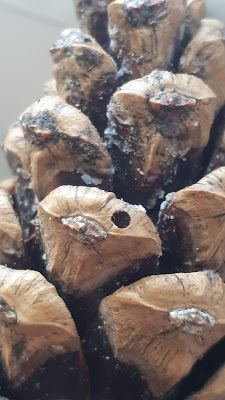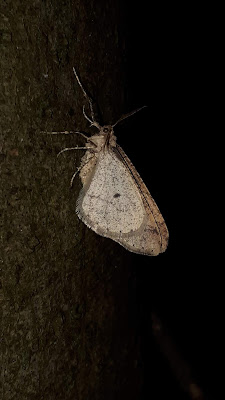Week ending 24.2.19
A spell of mild weather prompted many a moth-er to start trapping again. Although I have been trapping on and off all winter, there have been some very lean spells while we we having cold nights. Even this week, mild daytime temperatures have fallen away quickly to give us some rather chilly nights and even frosts. However, the first hour or two after dusk can still be productive in the garden.
18.2.19 - A nice day but the temperature dropped to 7 degrees overnight. Only 1 moth turned up to the 60 watt Actinic trap but it was a year first and a lovely moth; an Oak Beauty.
On the same evening I had asked Jackie at Hundred River Farm to run her 20 watt trap. Only 3 moths arrived to her trap; Pale Brindled Beauty, Spring Usher and an Agonopterix heracliana.
| Pale Brindled Beauty |
| Spring Usher |
| Agonopterix heracliana |
19.2.19 - A Dotted Border to the lounge window was the only adult moth but 2 Angle Shades larvae wandered into the trap. I was pleased to find my first brown form of this caterpillar. So far this year, more Angle Shades than any other caterpillar have come to the moth traps although Lesser Yellow Underwings are close behind with 2 more being found around the 60 watt actinic on this evening.
20.2.19 - A milder night produced a rare visitor to my garden trap; Tortricodes alternella. Although common in woodland around the region, only 2 have ever made it on to my garden list. Three Common Plumes (Emmelina monodactyla) were in and around the traps and after the first check I thought that was it. It was, therefore, a welcome surprise to find a Pale Brindled Beauty nestled inside the trap when I looked later in the day.
On closer inspection the Pale Brindled Beauty was really well marked and deserving of a photo shoot before release. It was probably the nicest specimen I've seen.
21.2.19 - After another glorious day the temperature looked promising for this evening. Indeed, at lighting up time the temperature in my garden was still holding up at 11 degrees celcius. I decided to give the mercury vapour bulb a try which lights up the garden and often brings in more moths. The only downside is that quite often the moths don't make it to the trap but instead settle on fences and garden furniture so they can be hard to find. As hoped, it was a very good evening for moths and although the temperature eventually fell to 2.1 degrees, it had remained above 6 until after 11pm so 7 species of moths made it onto my list; my highest February tally. Highlights included a second Tortricodes alternella in as many days, March Moth and two new moths for 2019; Early Grey and Common Quaker.
Other moths on this night included Chestnut and another Pale Brindled Beauty which seems to be having a great year both in the .
24.2.19 - Sunday night followed another gloriously sunny day but unfortunately the temperature fell away sharply and by 10pm there was a light frost. The minimum temperature was -1.4 degrees and only 2 Emmelina monodactyla and a few caterpillars showed themselves in the garden.
25.2.19 - Last but certainly not least... My wife took the kids to woodland playgroup today and found a pine cone with the exit hole of a Cydia conicolana. This is the third site at which we have found it locally proving that it is very under-recorded and is almost certainly far more common that previously thought.
 |
| Angle Shades caterpillars |
20.2.19 - A milder night produced a rare visitor to my garden trap; Tortricodes alternella. Although common in woodland around the region, only 2 have ever made it on to my garden list. Three Common Plumes (Emmelina monodactyla) were in and around the traps and after the first check I thought that was it. It was, therefore, a welcome surprise to find a Pale Brindled Beauty nestled inside the trap when I looked later in the day.
 |
| Pale Brindled Beauty trying to hide! |
On closer inspection the Pale Brindled Beauty was really well marked and deserving of a photo shoot before release. It was probably the nicest specimen I've seen.
| A real beauty - Pale Brindled Beauty |
21.2.19 - After another glorious day the temperature looked promising for this evening. Indeed, at lighting up time the temperature in my garden was still holding up at 11 degrees celcius. I decided to give the mercury vapour bulb a try which lights up the garden and often brings in more moths. The only downside is that quite often the moths don't make it to the trap but instead settle on fences and garden furniture so they can be hard to find. As hoped, it was a very good evening for moths and although the temperature eventually fell to 2.1 degrees, it had remained above 6 until after 11pm so 7 species of moths made it onto my list; my highest February tally. Highlights included a second Tortricodes alternella in as many days, March Moth and two new moths for 2019; Early Grey and Common Quaker.
| March moth |
| Tortricodes alternella |
| Common Quaker |
| Early Grey |
Other moths on this night included Chestnut and another Pale Brindled Beauty which seems to be having a great year both in the .
24.2.19 - Sunday night followed another gloriously sunny day but unfortunately the temperature fell away sharply and by 10pm there was a light frost. The minimum temperature was -1.4 degrees and only 2 Emmelina monodactyla and a few caterpillars showed themselves in the garden.
25.2.19 - Last but certainly not least... My wife took the kids to woodland playgroup today and found a pine cone with the exit hole of a Cydia conicolana. This is the third site at which we have found it locally proving that it is very under-recorded and is almost certainly far more common that previously thought.
 |
| Cydia conicolana exit hole |

















